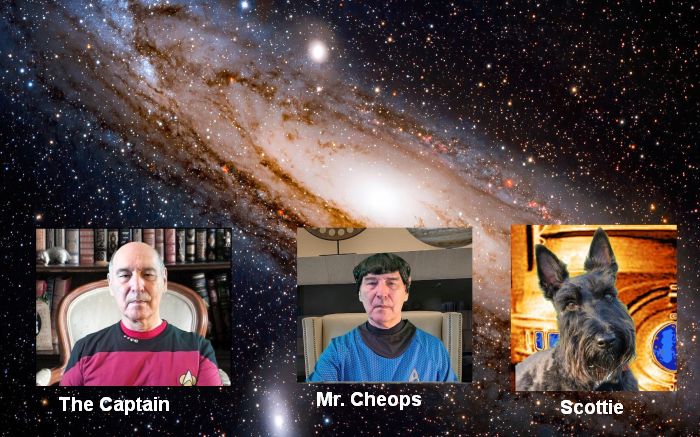
This starship adventure explores the characteristics of the Carolina Bays and examines the theories of their formation.

Transcript:
This is a story about starships, galaxies and Carolina Bays. Let's go.
12,900 years ago, a comet impacted the third planet from the Sun...
[music]
CAROLINA ENIGMA
Episode I
VIEW FROM EARTH ORBIT
An attempt to reach the Andromeda Galaxy
went horribly wrong.
The dilithium crystals that we bought from the Ferengi
turned out to be just quartz crystals. We were scammed.
With only impulse power, our starship cannot achieve
warp speed.
The crew is stranded in
Earth orbit,
so we will study the
Carolina Bays.
[captain] Our current mission is to study the Andromeda Galaxy. Two billion years from now, our Milky Way Galaxy will collide with the Andromeda Galaxy. The collision will take place for several million years and result in one combined super galaxy named Milkomeda. The sun may become part of the Andromeda system during the collision and could eventually end up far away from the new merged galactic center.
Welcome to this mission to the Andromeda galaxy. Our starship is equipped with the latest technology and we have an experienced crew. Scottie is our chief engineer. Mr. Grinder is in charge of navigation. Mr. Popov is our remote sensing specialist, and Vulcan science officer Cheops is joining us on this mission.

Mr. Grinder, set coordinates for the Andomeda Galaxy. Engage!
[computer] This is the navigation computer. The Andromeda galaxy is 2.5 million light years away. At warp factor 9 it will take 2,997 years to get there. This is impossible in your lifetime. For this reason, your destination has been changed to the Carolina Bays.
[captain]
Captain's Log: Stardate 2021.12.01
An attempt to reach the Andromeda Galaxy went horribly wrong. The dilithium crystals that we bought from the Ferengi turned out to be just quartz crystals. We were scammed. With only impulse power, our starship cannot achieve warp speed. We are stranded in Earth orbit.
Scottie, can you explain what is wrong with the warp drive?
[Scottie] Aye Capt'n. There's nothing wrong with the bloody thing. It's just that those fake dilithium crystals do not work.
[captain] Oh, Scottie, you look so different. What happened to you?
[Scottie] It's the darned radiation from the warp core. It has mutated me into a Chewbacca with big ears. I can hear much better now, and I can even bark [arf]. But I can still perform all of my duties.
[captain] OK, carry on Scottie. Since we are in Earth orbit we will take the opportunity to study the Carolina Bays. Mr. Popov, zoom in on the east coast of the United States.
[Popov]
Yes, Captain. We are zooming in on Herndon Bay in North Carolina.
We can get a better image using LiDAR with a topological color gradient. The Carolina Bays have raised rims and they are all oriented toward the southeast.
And look! The Carolina Bays are perfectly elliptical. This is a remarkable geological feature.
Mr. Cheops, what could have created the Carolina Bays? Maybe they were formed by a micronova event or electric discharges from the electric universe?
[Cheops] Mr. Popov, are you nuts? Have you also considered unicorn farts as an eolian mechanism or footprints of low-flying purple elephants? Maybe? Stop being ridiculous, we should stick to material science.
[Popov] Он такой противный. Он все знает.
[Cheops]
I heard that. I do not tolerate illogical hypotheses. All the planets and moons of our solar system were formed by accretion and have a long history of cosmic impacts. You only need to look at the surface of the Moon to understand that impacts are the most common mechanism for forming craters.
Furthermore, oblique impacts on a viscous surface create penetration funnels that are inclined conical cavities and they look elliptical when viewed from above.
[Popov] Captain, we have detected similar geological features in Nebraska, but notice that they are all oriented to the southwest. And they are also elliptical with raised rims like the Carolina Bays.
[Cheops] Captain, it is evident that well preserved Carolina Bays are elliptical. Ellipses are conic sections, so it is logical that the Carolina Bays originated as inclined conical cavities. Their superposition and their radial alignment from a common point of origin add further support for their creation as secondary impact structures. The raised rims are characteristic of impacts because impact cratering displaces material laterally by horizontal compressive forces and ejects debris ballistically to produce stratigraphically uplifted rims. It is very likely that a meteorite impact by the Great Lakes during the ice age ejected pieces of glacier ice whose impacts formed the elliptical features in Nebraska and in the East Coast.
[Popov] Wait a minute! There are some Carolina Bays by the Savannah River that are not elliptical. Could they have been formed by wind and water mechanisms?
[Cheops]
Our analysis indicates that the bottom part of the bay is elliptical, but the part on higher terrain has become distorted by mud flow into the cavity.
Experiments demonstrate that a perfectly elliptical impact structure gets deformed when it forms on inclined terrain. The gradient is steeper on the upper part of the cavity and mud flows faster on the uphill side during viscous relaxation.
Impacts on inclined terrain are always deformed in this particular way. This is why all the Carolina Bays in the hill by the Savannah river have an elliptical end and a flattened end.
[Captain] Thank you for your very logical explanation. Say goodbye Mr. Cheops.
[Cheops] Live long and prosper!
[Captain]
He is a very good science officer, but he cannot follow instructions.
I tell him to say goodbye and he says live long and prosper.
Thank you for joining us in this adventure. We need to explore the universe, but before going to the stars we should learn about the Earth. Read all about it. Engage!